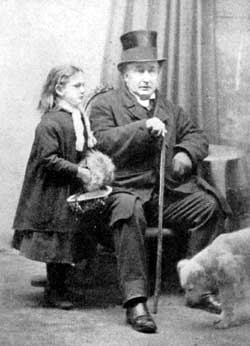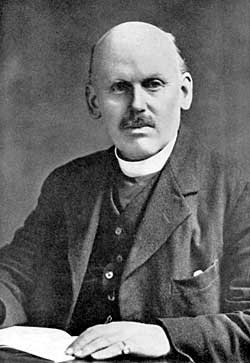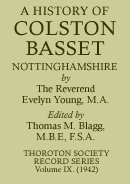< Previous | Contents | Next >
Chapter V.
Ecclesiastical affairs (2)
VICARS OF COLSTON BASSETT.
A full list is given by Godfrey; it is not proposed to reproduce this list here, but only to give some particulars, about the later vicars, which are not given in his book. Indeed, before the end of the 16th century, no particulars have been found.
Francis Chapman, instituted 12th April, 1592, was of Christ’s College, Cambridge, having matriculated in December, 1587. He probably became afterwards rector. of West Markham and Bevercotes, and died at Bevercotes in 1616. He was succeeded here by Roger Jacson or Jackson, ALA., instituted 4th January, 1595-6. He was born at Mansfield Woodhouse, and was educated at Mansfield and Sheffield schools, proceeding to Christ’s College, Cambridge, in 1584. His incumbancy included the plague year, 1604, and the Civil Wars; in addition to these, he appears to have been much troubled by the Roman Catholics, several of whom, including the Goldings, resided in the parish. In 1650 the vicarage was worth £40 a year, but the vicar, being disabled by age from performing the duty, employed one Roger Litherland clerke to supply the cure …. the said Mr. Litherland preachinge once every lords day and sometimes twice.” Mr Jackson died 22nd April 1651 at the age of 86, and was buried in the chancel on the following day he had held the living for over 55 years. In his will dated 15th March, 1649, he left 40s. to the church of Colston Bassett and 40s to the poor. Legacies were left to Roger Wilson of Mansfield Woodhouse; Roger Jackson of Oxton; William Litherland, of Colston his wife Elizabeth and his daughter; Elizabeth Thomas Cooper of Willowbie on the Woldes and his wife Ann; and William Jackson senior of East Bridgford. Roger Litherland, son of William was residuary legatee and sole executor he proved the will 12th June 1652.
Roger Litherland, B.A. succeeded his great-uncle as vicar in 1651. He was a native of this parish and was baptized here 17th March 1621; his father William Litherland, husbandman, had married, 26th October 1620, Elizabeth Jacson, a niece of the last named vicar. He was admitted at Pembroke Hall Cambridge 13th June, 1637, and afterwards at Christ’s College 7th April, 1639. On 6th September 1650 he married, at Screveton, Sibill, eldest daughter of Edward Holland, of Kinoulton gent. From this time the name is always written Leverland. He was rector of Weston, near Newark, from 1661 until his death on 10th August 1687 in his 66th year. In 1685 he gave evidence in the case of Bleay versus Golding about the tithes of Colston Bassett. His deposition. includes a list of the glebe:— “The closes belonging to the vicar were the Church Yard, the Homestead (Walker Yard and Finses Yard besides the ancient homestead belonging to the vicarage), the Stubble Close and the Allensicke and another parcell of ground called the Gallion Close in lieu of which the Hill Close was laid to the vicarage in his great-uncle’s time.”
Michael Richards, M.A., instituted 8th April, 1661. He was admitted to Trinity College, Cambridge, in 1633, and was ordained deacon at Peterborough, 24th September, 1637. In 1650 he was officiating the cure of Cropwell Bishop, receiving the profits of the vicarage worth £10 a year, for his salary, preaching but once every Lord’s day. He died 5th July, 1680, and was buried in the north aisle of Cropwell Church ; the inscription there describes him as “Master of Arts of Trinity College in Cambridge, a humble and faithful minister of the true and living God.” He probably belonged to the very numerous family of Richards of Cropwell.
William Bleay, MA., instituted 18th February, 1679-80, and inducted 22nd February, by Rev. Charles Wainewright, vicar of Bunney; he read himself in on 29th February, and entered a record of this on the fly-leaf of the earliest register, one of the witnesses being Thomas Bleay, rector of Saxilby. Mr. Bleay was admitted at Emmanuel College, Cambridge, coming from Leicestershire. He was ordained priest at St. Martin’s, Leicester, 10th August, 1608. In 1685 Mr. Bleay took legal proceedings against Dame Mary Golding and Sir Edward Golding, with respect to the vicar’s tithes; apparently he refused to accept payment from them on a composition agreed to by his predecessor. The various depositions in the case give some very interesting information as to the payment of small tithes in kind. Moreover we get a list of closes, with their names and area, owned by the Goldings ; these are all meadow and pasture, arable lands, if any, being omitted, as not being liable to vicarial tithes.
The total area of meadow and pasture is about 1400 acres, stated to be of the average yearly value of 10s. an acre : they include “the three fields,” with an area of 540 acres, said to have been recently enclosed in Sir Charles Golding’s time. All the homesteads were worth a total of £40 a year, the husband-men being eleven in number.
Mr. Bleay was buried here 4th May, 1721. There is an entry, on the fly-leaf of the register, of his gift to the church of a carpet or covering for the communion table, to be carried up to the church and brought down again by the clerk to the vicarage on these days, viz. Michaelmas Day and two Sundays following; on Palm Sunday, Easter Day and Low Sunday; and on Trinity Sunday. This gives us the three seasons in the church year when the Holy Communion was administered.
Thomas Rose, M.A., instituted 8th June, 1721. He was the eldest son of Richard Rose, of Derby, clerk ; at school at Derby, and admitted to Sidney College, Cambridge, 27th May, 1710, at the age of 17. He was ordained deacon 1714-5 and priest 1717 in York diocese. From 1749 he was also rector of West Bridgford, where he probably resided, the duty of Colston being performed by a curate. He was buried at West Bridgford 16th March, 1764.
In 1743 Archbishop Herring held his primary visitation of the Diocese of York, of which Nottinghamshire then formed part. The returns made by the clergy, in answer to the articles of enquiry, are now in process of publication by the Yorkshire Archaeological Society; those relating to this county have not yet been printed,1 but I have been favoured by Rev. P. C. Walker, rector of Lockington, with a copy of the answers returned by Mr. Rose. From this return we learn that there were 28 families in the parish, two of these being anabaptists and two popish families, the actual number of papists being given as 12. The anabaptists had no meeting-house. The papists in this parish and the adjacent villages assembled privately at a house in this town once in six or eight weeks, being taught by Mr. Busby, a reputed popish priest, it was said that, in Sir Edward Golding’s time there were but three persons in the parish qualified to serve the parish offices. The Sacrament of the Lord’s Supper was administered at least four times in the year, there being 49 communicants in the parish; of whom about 36 usually receive.
John Wright, M.A., of Jesus College, Cambridge, and of Mansfield in this county, was inducted to Colsten Bassett 3rd August, 1764. He had already been curate here for about three years. From 1766 he appears to have been non-resident. He was also for many years vicar of Kinoulton. He died at Mansfeild 13th July, 1900, and was buried at Skegby; for the last 18 months of his life he was hopelessly paralized. Probably he was the Rev. Mr. john Wright, curate, who was married at Mansfield to Mrs. Alice Mompesson, 24th October, 1742 ; if so, he must have been well over 80 when he died.
Joshua Brooke, B.D., instituted 10th December: 1800. He was born 29th November, 1760 at Gamston rectory, being the youngest son of the rector, Rev. Samuel Brooke. Joshua Brooke, clerk, and Sarah Bailes were married at Newark, 21st September, 1795. Before coming to Colston he had been vicar of Hagworthingham and Scrayfield, Lincolnshire, from 1790. He became rector of Gamston in 1812. In 18l4 he resigned from Colston, but continued to hold Gamston till his death on 12th March, 1851, at the age of 90. In 1783 he had been appointed master of St. Leonard’s Hospital, Newark, in those days a very lucrative appointment, which he held, I believe, till his death.

The Rev. Joshua Brooke (vicar from 1834 to 1888).
Joshua Brooke, M.A., instituted July, 1834, on the resignation of his latter; of whom he was the only son, having been born at Newark vicarage, 4th October 1809. He went to Exeter College, Oxford, in 1828. He was also curate of Tithby from 1834 to 1879; on 7th August, 1879 he was licensed to Owthorpe, which lie held till his death. When he came here in 1834 probably the old vicarage was in a state of decay; in that year a loan was obtained from Queen Ann’s Bounty to help towards the building of the present house. At the same time there seems to have been a slight exchange of land with Mr. Martin, in order to straighten the boundary between his property and the glebe. Mr. Brooke died 30th April, 1888 after a long incumbency of nearly 54 years. There is a brass tablet in his memory in the new church.
Joseph Adamson, M.A. of St. John’s College, Cambridge, instituted 4th February, 1889. It was during his time that the church of St. John the Divine was built by Mr. Knowles; it was consecrated 2nd August, 1892, and became the parish church. The actual building of the old church of St. Mary became Mr. Knowles’ property, but it seems a great pity that the ecclesiastical commissioners insisted on its being thoroughly dismantled, even to being unroofed.2
Archibald James Bennoch, M.A., of Hertford College, Oxford, and M.A. of Durham University, instituted 11th June, 1897. He had been vicar of St. Lukes, Woodside, Surrey, for 24 years, and exchanged with the last-named; he resigned in 1900.
Michael Hallett Pimm, of Chichester Theological College, instituted 3rd February, 1901. He resigned 3rd January, 1912, and is now rector of Sutton-on-Derwent, Yorkshire.
Charles Henry North Ivens, of Lincoln Theological College, instituted 8th March, 1912. He resigned 31st October, 1923, on an exchange with his successor, for the rector of Roughton, Norfolk, and is now rector of Dalmahoy, Edinburgh, and chaplain to the Earl of Morton.

The Rev. Evelyn Young (vicar from 1924 to 1936).
Evelyn Young, M.A., of Christ’s College, Cambridge, instituted 9th January, 1924. Died 15th April, 1936.
John Booth, M.A., of Exeter College, Oxford. C.M.S. missionary in Travancore, 1902-1907. Rector of Caenby with Saxby, Lincs., 1909-1914. Vicar of Reepham, Lincs., 1914-1936. Instituted 12th August, 1936.
CURATES.
From about 1749 to 1834 the different vicars were mostly non-resident, the duty being done by resident curates, who probably lived in the old vicarage. The following list is probably incomplete ; it is drawn from the registers, and the dates given are only approximate.
James Purcell, 1755 to 1758. A daughter was baptized here in 1758.
W. Smith, 1758 to 1759.
John Wright, 1761 to 1764, in which year he became vicar.
Nathaniel North, in 1767.
James Swann, 1769 to 1770. His will was proved 1st December, 1772, as “late curate of Colston Bassett”; but there is no record of his burial here.
Philip Story, in 1772.
William Gill, 1772 to 1782. During this time he had six children baptized here.
Edward Crosland, 1784 to 1790. He was married at Langar, 25th February, 1786, his wife being Sarah, daughter of Gervase Howe, and three children were baptized here. He died, while still curate, and was buried at Langar 26th June, 1790.
John Smith, 1790 to 1796.
Edward Smith, 1798 to 1822.
Thomas Smith, 1822 to 1833. These Smiths together with a Henry Smith, appear to have done the duty of all the nonresident clergy of the neighbourhood.
Thomas Hoe is stated by Godfrey to have been curate-in-charge of Kinoulton, Colston Bassett and Cropwell Bishop at the time of Mr. Wright’s death in 1800. As regards this parish the statement is hardly borne out by the registers. Anyhow he officiated here occasionally and he was connected with this parish, having been married here on 6th July, 1796, to Ann, daughter of Thomas Crabtree. He was at that time vicar of Dalby on the Wolds, which benefice he held till 1803, when he became vicar of Long Clawson and remained so till his death. He also held Kinoulton from 1800 till his death. His wife was buried 8th October, 1803, and he on 14th March, 1818, aged 88 — both among the Crabtrees in Colston Bassett churchyard.
This chapter would be incomplete without some reference to other forms of worship besides that of the established Church. The fact that Sir Edward Golding, the first baronet, was a zealous Romanist, will account for there being a considerable proportion of Roman Catholics in the parish in the 17th century. In those days recusancy, or refusal to attend the services prescribed by law, was a punishable offence so also was separatism, the attending of services other than those prescribed by law. Consequently both Roman Catholics and Puritan Dissenters were liable to be presented at the Sessions as law-breakers; and the Sessions Rolls of the county give the names of those who were thus presented, Mr. H. H. Copnall, in his book on the "Nottinghamshire County Records," gives three lists of Colston Bassett people who were presented. The first list gives 17 popish recusants during the reigns of James I and Charles I. The second list is of popish recusants presented in 1660, eleven in number. The third list covers the reigns of Charles II and James II, persons presented for “absence from church for one month,” 20 in all, probably most, if not all popish recusants. In 1669, in answer to an enquiry as to conventicles in the different parishes, the vicar, Michael Richards, wrote “These are to testify you and others whom it may concern, that there is none other conventicle held in this town, but only by the popish recusants, whose names have been formerly presented to you at your visitation, the Lady Golding’s house being the place of their meeting.” A Roman Catholic chapel was erected in the village in 1810 so it is to be supposed that there was then the nucleus of a congregation, but no service has been held in it for some ten years past.
The present Methodist chapel is mentioned in the Tithe Award as a Ranters’ chapel. By indentures dated 27th and 28th December, 1838, George Marriott, of Colston Bassett, gentleman, sold a small piece of land, part of the first Home Close, to twelve trustees, on special trust that an edifice calculated for a chapel or meeting-house and school may forthwith be erected by the members of the Independent Primitive Methodist Connexion at Colston Bassett and the neighbourhood; to be used for a chapel for religious worship, and a place for the instruction of poor children in religious and useful knowledge. If the funds became so reduced, that the chapel could not be supported, or so increased as to afford a larger chapel if required, the trustees had power to sell and absolutely dispose of the same, or to purchase or erect a larger chapel. Provision was made for the further appointment of trustees, if the number be reduced to three or less. The trust deed was enrolled in the High Court of Chancery, 11th February, 1839. Of the original trustees John Simpson, Edward Wing, laborer, John Skinner, laborer and Samuel Howitt were of Colston Bassett; seven were of Bingham and one of Ratcliffe.
On 9th August, 1881, upon the application of John Skinner, then of Scalford, co. Leicester, sole surviving trustee, an order was made by the charity commissioners for the appointment of new trustees. Fifteen were appointed, of whom John Gregg, Edward Etches, Benjamin Barnett, William Etches, John. Newton, John Brewster and Thomas Crampton, labourers, Frederick Chambers, gardener, and Harry Loseby, engine-driver, were of Colston Bassett, while the remaining six were of Bingham.
On 30th December 1806 the Independent Primitive Methodist Connexion at Colston Bassett having become so reduced that the chapel could not be supported the eleven surviving trustees conveyed the premised to the Wesleyan Methodists the conveyance being made in accordance with the Model Trust Deed of that body. Of the fifteen trustees then appointed John George Marriott, farmer, William Salvin bricklayer, William Etches and William Richards, labourers, were of Colston Bassett the rest belonging to neighbouring parishes.
< Previous | Contents | Next >
1. This has since been published (Yorkshire Record Series, vol. 77, 1930). Mr. Rose states he was at that time living in the vicarage house and that he had no curate. He gives a very full and conscientious report of religious conditions in the parish in 1743. T.M.B.
2. This is a customary rule, to prevent usage as a secular building—for instance, as a barn or cattle-shed. T.M.B.
